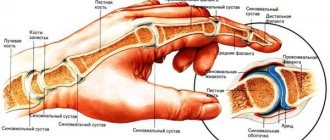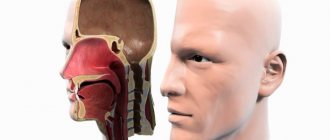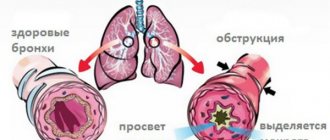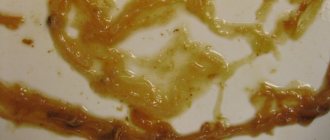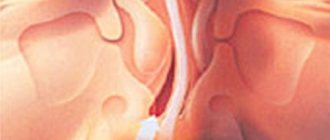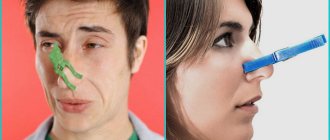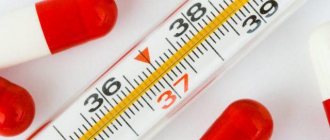How to cure a runny nose in a child quickly and effectively at home
A visit to a children's clinic does not exclude the fact that the main treatment of rhinitis is carried out at home, adapting to the various characteristics of a particular organism, since each case is individual. Treatment is accompanied by compliance with basic rules, which bring noticeable relief and help strengthen the immune system.
Drink plenty of fluids
This condition works in the treatment of most colds. Drinking helps reduce viral intoxication in the body. Due to the large amount of fluid consumed, the frequency of urination increases, and a rapid process of cleansing the body occurs. Properly selected drinks help to liquefy viscous secretions, as well as eliminate swelling of the mucous membrane. It is customary for children to prepare fruit drinks from cranberries, lingonberries, and currants. Herbal teas with chamomile, lemon balm, and thyme are effective.
Control of room temperature
Dryness and increased air temperature in the children's room lead to worsening rhinorrhea. The snot becomes sticky or dries out. Such a secret is an ideal environment for the proliferation of microorganisms. Therefore, room ventilation, constant humidification and the use of alternative methods of eliminating dryness are necessary in the treatment of nasal congestion.
Diet
Another condition for successful treatment is clear diet planning. Certain dishes will help cure a runny nose by reducing the viscosity of mucus and relieving swelling. For rhinitis, berry juices, compotes, liquid porridges with oatmeal and butter are indicated. For the second course, mashed potatoes and sticky rice are often prepared. It is strictly forbidden to give sweets, rich soups with meat, yeast or biscuit pastries.
Rinsing or irrigating the nose
Of the procedures that directly affect the physical condition, frequent washing or irrigation is especially effective. The methods are fundamentally different. Rinsing before reaching 2-4 years of age is contraindicated, therefore, when they talk about rinsing in children, they often mean irrigation of the nasal cavity.
After irrigation, the mucous membrane is moistened and local irritation is reduced. Sprays or drops are used for irrigation. They can be purchased at pharmacies or prepared yourself. Pharmaceutical products are formulations with sea water or sterile saline solutions. After irrigation, it is advisable to blow out the contents and instill vasoconstrictor drops if necessary.
When washing, the technique will be different. Rinsing helps to quickly treat a runny nose in those over 5-6 years old. For this method, use a special kettle or tank with a long spout. It is used to irrigate one nostril while slightly closing the other. If the technique is performed correctly, the liquid should pour out of the second nostril. Then the actions are repeated.
Prevention
To prevent the development of a runny nose in young children, you need to follow simple rules:
- Constantly humidify the air in the children's room, using special devices or, in extreme cases, water containers placed around the room. It is especially important to humidify rooms during the heating season.
- Ventilate the room as often as possible. You need to ventilate your baby’s room at least twice a day for at least 10 minutes.
- Ensure the correct temperature - the room should not be too hot. The optimal temperature is 18-20 degrees.
- Carry out wet cleaning in the nursery every day.
- From time to time, you can irrigate the baby’s nasal mucosa with products based on sea water.
- Walk with your baby in the fresh air as often as possible and be sure to ventilate the room.
- Practice breastfeeding.
- Do not vaccinate when the baby has a runny nose or other illnesses.
- If one of the adults has a cold, he needs to wear a gauze bandage and change it every two hours. It is important to wash your hands as often as possible and avoid contact with the baby.
How to cure a runny nose
Rhinitis can be eliminated at home. For example, allergic rhinitis requires taking antihistamines. Antiallergic drugs are prescribed orally and locally. If a bacterial runny nose is detected, you can use an antibiotic to destroy the pathogenic flora. Conservative therapy should begin with a final diagnosis; other medical measures are presented below:
- It is necessary to systematically clear the nasal passages of mucus by rinsing the nose and blowing the nose.
- Use vasodilators locally, thereby stopping an acute attack and speeding up remission.
- If the nasal passages are swollen and painful, the doctor recommends performing physiotherapeutic procedures in a hospital setting, for example, inhalations.
- To rinse the nasal passages, it is necessary to use products prescribed exclusively by the attending physician, strictly for medical reasons.
- In complicated clinical situations, surgical treatment methods may be required to remove mucous secretions.
Drops
More often, attending physicians prescribe nasal drops with an antibacterial or antiseptic effect; their therapeutic effect is local - directly on the site of pathology. Adults and children can cure a runny nose in this publicly available way, so the most common pharmacological groups and their representatives are presented below:
- prescribing vasoconstrictor drugs such as Sanorin, Nazivin, Galazolin, Ximelin;
- the use of saline solutions, as an option - Aqua Maris strong, Quicks, Physiomer hypertonic;
- using isotonic solutions, for example, Humera, Aqua Marisa, Aqualor, Marimera, Dolphin.
Before using drops in the nasal passages, you need to correctly select an effective medicine with minimal side effects. The following nasal drops are especially effective and affordable:
- Nazivin. Nasal drops that can be prescribed to adults and children. Active components relieve inflammation, irritation of the mucous membrane, and relieve pain. 1-2 drops should be administered into each nostril. The duration of intensive therapy is 10–14 days, no more.
- Sanorin. The drops have a similar principle of action to the medication described above and are intended for nasal administration. Adults are recommended to administer 2–3 drops into each nostril for a week. Then it is necessary to change the medicine for snot.
Inhalation with a nebulizer
This is another effective method for treating a runny nose, and it is appropriate to use it at home. Adult patients inhale the vapors of the medicine, irrigate the mucous membranes, and relieve severe inflammation. Drops of essential oil or sea salt can be used as a healing composition, but in modern pharmacology there are other, no less effective medications. This:
- Isofra. It is recommended to treat complicated runny nose (green snot) in this way. To carry out home inhalation, you need to pour 2 ml of Isofra solution and saline solution into the nebulizer chamber. It is recommended to use this drug up to 3 times a day for 2 weeks.
- ACC. This amino acid perfectly fights dangerous viruses and bacteria, but before using it, you need to pour the composition into a special nebulizer. For one inhalation, 2.5-3 ml of solution is required. The procedure should be carried out 2 times a day, for 1 – 2 hours after the session, do not drink anything, do not eat anything, and do not go outside.
How to cure a runny nose at home for a child
Olya With an idiot argue…
How to cure a runny nose at home? To cure an incipient runny nose, you need to warm up your sinuses several times a day. To do this, heat the salt in a frying pan and put it in 2 bags. Place napkins on either side of your nose and bags on them. Instead of salt, you can heat the egg and apply it alternately on each side. If the runny nose is purulent, use special drops or a saline solution to treat it. After it becomes transparent, bury 5 drops of carrot and beet juice in your nose. How to cure a runny nose at home in infants? When treating an infant for a runny nose, start by ensuring that the room has the correct humidity. To do this, place a bowl of water in the room. The temperature in the room should be from 22 to 23 C. It is better to take the baby and, having opened hot water in the bathroom in advance, go in there. The hot steam will make your baby discharge, so wash him. Repeat this procedure every 30 minutes. Bathing your baby in herbal baths will also be effective. Take calendula, sage and chamomile and brew them with boiling water. Pour the prepared broth into the bath and dilute with water, the temperature should be 36 C. Bathe your baby for 20 minutes. If you have a severe runny nose, you can use saline solution. Place 3 drops in each nostril every 30 minutes. Treatment of runny nose in children at home First, the child needs to rinse the nasal passages. To do this, prepare a decoction of mint, thyme, sage, or chamomile, calendula. Pour 0.2 liters of water and boil it. Add 1 teaspoon of any of these herbs and mix thoroughly. After 2 hours, strain the solution. Before use, the temperature of the infusion should be 37C. Lay the baby down so that the head is tilted back slightly. Insert 1 pipette of infusion into each nostril. Afterwards, the baby should raise his head and try to blow his nose. Repeat the procedure 3 times. If the baby cannot blow his nose, place him on his side with a diaper folded 4 times under his head. Using a syringe, suck out the mucus from the left nostril if the baby is lying on the right side, injecting the infusion into the right nostril. Then turn the baby over and repeat all over again. Your baby's feet should be warm all the time, so put woolen socks on him. Steam inhalations for the treatment of runny nose in children Steam inhalations will also help to cope with a runny nose in young children. It is better to do them when the baby is sleeping. To do this, pour 0.5 liters of water into a saucepan and boil. Add 3 drops of fir, or eucalyptus, or menthol oil, you can also use star balm, a small piece will be enough. Mix everything and, after keeping it on low heat for 4 minutes, put it in a warm place, covering it with a lid. After 15 minutes, check if it is too hot. To do this, place the pan at the level of your face and a distance of 50 cm from you. If the steam gives you a pleasant feeling of warmth, you can use it; if it burns, wait until it cools down a little more. Then place the pan on a high chair, next to the baby’s crib at a distance of 50-60 cm and remove the lid. Cover the pan with a diaper and lift the other corner so that the steam hits the baby's face. Inhalation time is no more than 7 minutes. When treating a runny nose in infants and small children, you need to be especially careful. If a runny nose is accompanied by a high temperature or severe weakness, be sure to consult a doctor, this especially applies to the health of your children. A runny nose can be cured at home with the help of herbs, salt, steam inhalations with essential oils, and walks in the fresh air. But try to prevent the development of a runny nose from the very beginning. Take care of yourself and your loved ones.
****** *
https://ladyspecial.ru/zdorovie/narodnaya-mediczina/bolezni-i-lechenie/kak-vylechit-nasmork-v-domashnikh-usloviyakh read here
What is rhinitis?
“Runny nose” is the common name for rhinitis, an inflammatory process in the nasal mucosa. The main symptom of this disease is the intense formation of muconasal secretion (nasal mucus). The mucus itself does not pose a health hazard. It performs a protective function, moisturizes the inhaled air, traps dust particles, and has antiseptic properties.
With a viral or infectious disease, the amount of mucus secreted increases significantly. The body intensively produces muconasal secretions to neutralize microorganisms that disrupt the functioning of the nasopharynx. As a result, the patient suffers from profuse mucus discharge from the nose.
Important ! In childhood, infection from the nose often penetrates the respiratory organs, auditory tube, and paranasal sinuses. Rhinitis is especially dangerous for infants.
Runny nose in a child - 2 years old
What is a runny nose and why does it appear?
Snot is a natural reaction of any body to an attack by viruses or allergens. The nasal mucosa tries to protect the body from harmful invasion by increasing the secretion of mucus. That is, it turns out that this condition is not a problem at all, but it does cause discomfort? What to do - or not to treat a runny nose in a 2-year-old child?
A child has a runny nose - what to do?
In order for an unpleasant disease to pass as quickly as possible, it is necessary to create suitable conditions for this. Cool air between 18-20°C will be the best treatment. To keep the child warm, he needs to be well dressed, but the air should not be warmed additionally. If the apartment is hot, then the temperature can be reduced by regular cross-ventilation, during which the baby needs to be taken to another room.
The second component of a speedy recovery is the air humidity of the room in which the baby is awake and sleeping; for a sick toddler it should be in the range of 60-70%. To measure the saturation of air with moisture, every home must have a device - a hygrometer. When the indicators do not correspond to the norm, a modern air humidifier will come to the rescue - the gadget is very useful not only in a family with small children, but also for adults.
And finally, the third mandatory point is to give the baby plenty of water and often. Even if he refuses, you need to give lukewarm compotes, fruit drinks or clean water at least a teaspoon every 10 minutes. The body must not be dehydrated.
If the air is dry and warm, and the child does not drink liquid, this will very quickly lead to the mucus in the nose drying out and the nasal streams will be replaced by congestion, which is less tolerated by the child. But this is not the only problem. A dry nose, not protected by mucus, allows germs to pass further into the throat, trachea, bronchi and lungs. And a common runny nose develops into bronchitis or pneumonia, although it could have ended in the nose if measures had been followed.
Cold remedies for children
In order for the nose to breathe normally, especially at night, it needs help. First of all, these are a variety of saline solutions that abound on pharmacy shelves. You can make it yourself from boiled water and sea salt. You need to moisturize the mucous membranes with these salty drops every two hours. After a few minutes, the nose should be cleaned with cotton wool, and then oil drops should be instilled into it, intended for the treatment of a runny nose in a 2-year-old child.
Vasoconstrictor drops, as a rule, only worsen the situation. Firstly, they very dry out the nasal mucosa and even the nasopharynx, which leads to coughing and sore throat. Secondly, the nose is able to breathe freely for a while, but then it becomes blocked again and a vicious circle is formed, the body gets used to the drops and can no longer live without them.
Is it possible to cure a child’s runny nose with folk remedies?
Our grandmothers always knew how to rid a child of a runny nose. Many mothers still put their experience into practice today. Folk remedies can alleviate a child’s condition, but you just need to be sure that the baby will not respond with an allergic reaction to seemingly harmless homemade “medicines.”
At home, you can instill in your baby Kalanchoe juice diluted with water, a mixture of carrot, beet and honey juices - with a mandatory sensitivity test, because these are potential allergens.
You need to be careful with a decoction of oak bark and use it only for liquid snot, because it quickly dries out the mucous membrane. And don’t forget to lubricate your baby’s skin near the nose with Vaseline to prevent irritation from a runny nose.
WomanAdvice.ru>
Rhinitis in children: main symptoms
We will not consider here the manifestations of intoxication of the whole body (fever, malaise, lethargy), since they are well known to everyone and will focus only on local ones:
- nasal congestion. It is very easy to check: close one nostril and breathe “half-heartedly”. It turns out without tension - there is no symptom;
- rhinorrhea, or nasal discharge . They can be serous or serous-purulent. There is no purely purulent discharge from the nasal passages, but with puncture of the maxillary sinus you can sometimes get pus;
- sneezing. Everyone knows that its purpose is to clear the airways with the help of a reflexively caused push of air. The air speed when coughing and sneezing can reach 100 km/h or more. Sneezing is usually preceded by rich and varied sensations: burning, scratching, pleasant tickling.
- with atrophy of the mucous membrane (atrophic rhinitis), scanty dry crusts form instead of rhinorrhea;
- Since the secretion of mucus and tears have much in common, lacrimation can sometimes occur with a runny nose. Sometimes it occurs on one side, with sensations preceding sneezing;
- Hyposmia or anosmia is the inability to distinguish odors. This feeling is also familiar to everyone firsthand.
There are also other discharges from the nasal passages: for example, with a fracture of the base of the skull and ruptures of the dura mater, cerebrospinal fluid may leak from the nose and ears in rare cases.
Sometimes a child may have a runny nose with blood.
This symptom may indicate fragility of the blood vessels, which are damaged when sneezing or wiping the nose.
Sometimes blood may drip from the nose, causing nosebleeds. There is even a special area from which almost all nosebleeds originate - the Kisselbach area.
You should not be afraid of this symptom, you need to put the child down, throw back your head and put cold on the bridge of the nose, but for no more than five minutes, so as not to catch a cold in the maxillary sinuses.
You can roll up turundas from soft paper (napkins, toilet paper) and insert them into the nostril so as not to stain your clothes with blood.
Sometimes a nosebleed can simply occur because a child who doesn't cut his nails simply picks his nose.
to the content?
How to cure a child's runny nose
You can temporarily alleviate a child’s condition and relieve him of a runny nose by using special drops or sprays. They will clear the nasal passages so that the baby can breathe normally. But such remedies remove the symptom, and do not treat the cause of its occurrence. The medicinal impact should be on the underlying disease.
Drug therapy
Treatment of a runny nose in children necessarily includes the use of vasoconstrictor drugs. They will not affect the severity of the disease, but quickly and effectively eliminate congestion and pathological mucus. First you need to clean the nasal passages, and then use Nazol Kids, Nazol Baby or Xylometazoline. The maximum duration of use is 3–4 days, after which addiction begins and the desired result is lost.
When choosing products for children who are 3 years old, the emphasis is on medications with a herbal and natural base - Rinoxyl, Protorgol, Vibrocil or Pinosol. The dosage is determined according to age; all necessary information is indicated in the instructions for use.
Children 3–4 years old can also be given antiviral drugs: Arbidol, Viferon, Groprinosin or Anaferon. They are suitable when rhinitis is accompanied by fever or signs of intoxication, as well as when the baby’s immunity is low.
If a runny nose is caused by an allergic reaction, it is necessary to eliminate its source as soon as possible. Temporary congestion is often caused by dusty rooms, pollen, wool or too dry air. Remedies for the common cold will be useless until the baby is in an environment that is comfortable for his body.
Nasal rinsing
Rinsing the nose of very young children helps to clear the nose. Safe preparations based on sea water - Marimer, Aquamaris, Dolphin, Aqualor or Otrivin - are suitable for this. Babies will not be able to blow their nose on their own; parents will have to remove excess mucus. A soft bulb for douching is suitable for this.
For older children, you can prepare the rinsing solution yourself. To do this, mix a teaspoon of sea salt in a liter of warm boiled water. Everything is thoroughly mixed until the grains disappear. Rinsing can be done with or without a syringe. To do this, the baby must suck in the solution through one nostril and immediately blow it back out. To cure a runny nose in a child, the procedure is repeated 3-4 times a day.
Traditional methods of treatment
At home, treatment of a runny nose in children is often carried out using traditional medicine.
To strengthen the immune system and reduce the intensity of the inflammatory process in the nasopharynx, herbal infusions and teas are suitable. They are prepared using chamomile, calendula, licorice, St. John's wort or linden flowers. All herbs are mixed in equal proportions, a tablespoon is brewed with a glass (250 ml) of hot water. Leave for at least one hour. The resulting liquid is filtered and ready for use. To improve the taste, you should add a teaspoon of natural honey.
If a child 7 years of age or older has a runny nose, onions are used. One medium fruit is grated on a fine grater, and the juice is squeezed out of the resulting pulp. It is diluted with water or saline (proportions 1:1) and injected into the child’s nose. One drop in each passage 2-6 times a day is enough. For younger children, onions are replaced with carrots or beets.
Turundas also help relieve congestion. A small amount of calendula juice and sea buckthorn oil are mixed in equal proportions. Small cotton swabs are soaked in the liquid and inserted into the nasal passages for 20–30 minutes. Repeat the procedure up to three times a day.
General information
A runny nose is a very common disease that often occurs not only in adults, but also in the smallest children - infants. And if adults often simply do not pay attention to a stuffy nose, then rhinitis in a baby causes him noticeable discomfort.
Feeling unwell due to a stuffy nose, the baby is capricious, eats poorly and sleeps restlessly. Signs of nasal congestion in young children are not uncommon. After all, in newborns, the immune system is just developing, and any seemingly insignificant reason can lead to the appearance of mucus in the nasal passages. A runny nose often begins after hypothermia and accompanies allergic manifestations and autonomic disorders. It is important for parents to understand that even slight swelling of the mucous membrane in babies leads to difficulty breathing. This condition not only exhausts the child, but can also subsequently lead to complications when the inflammatory process spreads to the organs of the respiratory system. How to determine that a child needs help and what treatment methods are appropriate to use can be found in this article.
First aid
Rhinitis is an inflammatory process of the nasal mucosa, accompanied by increased secretion.
A severe runny nose causes a lot of discomfort to the child - nasal congestion, decreased appetite, and poor sleep. As a result, irritability and moodiness increase. As the inflammatory process spreads, body temperature may rise, weakness and decreased activity may occur.
Causes of snot:
- viral, bacterial infections;
- exposure to allergens;
- hypothermia or overheating;
- drop in the body's defenses;
- deviated nasal septum;
- getting a foreign object into the nose.
Some children start attending kindergarten (nursery) at the age of 2, and this is a lot of stress. Parents complain about constant discharge, but as soon as the adaptation period ends, the child’s snot goes away.
Effective treatment of a runny nose in children 2 years old begins with creating favorable conditions for recovery:
- the air temperature in the room should be within 18–20 °C, humidity – 50–70%;
- constant ventilation, daily wet cleaning;
- walks in the open air;
- plenty of drinking regimen (at least 1 liter of warm liquid - tea with lemon, rosehip decoction, currant compote);
- easily digestible food;
- taking vitamin C.
In addition, the emotional state of the little patient is important - the more positive his attitude is, the faster the body can cope with the disease. Therefore, you need to distract the baby, play with him, protect him from stressful situations
The basis of treatment for a runny nose in a 2-year-old child is rinsing the nasal cavity. Manipulations can significantly reduce swelling, wash away accumulated mucus along with pathogens, increase local immunity, stop the inflammatory process, and restore normal functioning of the mucous membrane. The ideal composition is saline solutions, which can be purchased at a pharmacy (Aquamaris, Dolphin) or prepared independently. Saline solution (sodium chloride) has a similar effect.
It is necessary to carry out the procedure correctly - the baby, in a sitting or standing position, should tilt his head to the side in the opposite direction from the nostril into which the solution will be instilled (sprayed). The same is done with the second side. After the manipulation, be sure to blow your nose well or suck out the mucus.
You can rinse more effectively (the most important thing is that the child is comfortable). To do this, you need to place your head over the sink with a slight tilt (as for washing). Inject the solution into one nostril, gradually increasing the pressure. Liquid should flow from the second nostril along with snot and pathogenic microorganisms. Repeat the same with the opposite side.
Causes
The reasons for the development of a runny nose in children may be associated with exposure to a wide variety of factors. Rhinitis develops due to the following reasons:
- viral and bacterial infections;
- influence of allergens;
- indoor air is too dry;
- exposure to toxins and other environmental factors;
- entry of a foreign body into the nasal cavity;
- the so-called “runny nose on teeth” - can begin when the baby is teething;
- hypothermia, overheating, sudden temperature fluctuations.
A runny nose in newborns is normal.
Your doctor should tell you about this if you ask him how a runny nose is treated in infants. Indeed, a physiological runny nose is not a disease, but a normal condition of the nasopharynx. Do not forget that the child has just recently come into this world, and his tiny body is learning to function effectively. It is snot that allows the nasal passages to adapt to environmental conditions. But normally they do not interfere with the child at all. Why does the condition sometimes worsen, the snot becomes thick, profuse, acquires a color or smell? This means that you are observing a bacterial complication, that is, the child did not find himself in the conditions that he needed.
Before asking your doctor how to treat a runny nose in infants, answer the following questions: “Is it too dry and hot in the room where it is located? Do you spend enough time outside, do you constantly ventilate?” If not, then this may be the answer. Besides, breastfeeding is the magic key. Sucking movements train the nasopharynx well, which means a runny nose will go away faster.
What to do if a runny nose is accompanied by a cough and fever?
You know how to treat a runny nose, but what to do if a child has a cough and a high fever? Here it is necessary to take serious measures to avoid further complications. Doctors prescribe complex treatment, since cough, high fever and runny nose are characteristic of an acute respiratory infection.
Grippferon drops are prescribed for the nasal cavity . If you have a sore throat, you can take a Tamiflu , and if you have a high temperature, take Paracetamol .
If the treatment does not bring a positive result, then it is necessary to replace one of the drugs with a stronger one. So you can replace Grippferon with a homeopathic spray, for example Edas . inhalations are necessary for a runny nose .
Important! If a child has a high body temperature, then inhalation cannot be performed. When the lungs are exposed to hot steam, the child’s temperature will begin to rise, which will be difficult to bring down in the future.
If there is no temperature, then inhalation is carried out for 5 minutes. fir and eucalyptus at home , or inhale it over potatoes.
We recommend that you read the article “How to treat a runny nose in 5-year-old children?”
How to cure a runny nose in a child aged 1.6 at home
ell04ka
1) provide normal humidified air in the house (cover the radiators with wet blankets) 2) no vasoconstrictor drops. This is a direct road to naphthyzine for life (((( 3) it is advisable not to drip ANYTHING, but if it is very difficult, then Mars salt water or similar harmless drops. If there is a high temperature, and in general flu symptoms, drip INTERFERON into the spout (the opened ampoule is stored for a day , in the refrigerator) If you are sure that there is a bacterial infection (low temperature, sore throat, cough, etc.) - appropriate treatment will be prescribed by the pediatrician, and then you can put ALBUCIDE (sulfacyl sodium) 1-2 drops into the nose
This is a sulfonamide drug that kills bacteria. Attention: there are (rare) allergies to any sulfonamide, like antibiotics, carry allergy medications with you
Laura Petrarkina:)
Collargol, Protargol - drops based on colloidal silver, they are prepared in a pharmacy (they are available in state pharmacies, you can’t buy them at kiosks). Sea salt solution - select a concentration such that it has a slightly salty taste. This is the same as Aquamaris. Salt is sold in pharmacies and supermarkets, but just don’t buy flavored salt. Vibrocil – vasoconstrictor drops (drop at night to ease breathing). Salin, nizivin (we haven't tried it). Pinosol - oil-based drops, penetrate well, can be used several times a day. At night, I hang a napkin in the crib and drip a few drops of aroma oil (fir, eucalyptus, tea tree) onto it. It turns out to be an “aroma lamp”, the air around the baby is purified, and breathing is easier. You can hang a gauze bag with chopped onions or garlic in the crib. Be sure to do wet cleaning and ventilate your baby’s room. A mixture of Oxolin-ointment + Pinosol-cream can be placed in the nose of a sleepy child (carefully, rubbing along the inside of the nostril). This helps out in cases where the child is capricious and does not allow the nose to drip, otherwise the baby’s psyche does not suffer. Bioparox is an antibiotic spray (if it’s really bad). Get well! https://video.komarovskiy.net/nasmork-il... School of Dr. Komarovsky > Runny nose and medications for the common cold.
Traditional methods of treatment
You can do without drug therapy, however, before starting treatment with the methods described below, you must consult a doctor.
A quick way to get rid of a runny nose is to perform steam inhalations. As a medicine, you can use a prepared decoction of plantain or eucalyptus at home.
Some doctors recommend steam inhalations with peach or anise oil for children aged 6 years. Such procedures will help to quickly eliminate swelling in the nasal cavities and in the child, and thereby resume normal breathing.
At the age of 6, a recipe based on beetroot or carrot juice can be used to treat a runny nose. To prepare, you need to boil the vegetables and squeeze out the juice, then apply drops to your child’s nose. To get positive results quickly, this recipe can be used together with garlic drops.
Making garlic drops at home is easy. It is enough to squeeze the juice through the garlic and then leave it for 7 hours. Once the garlic drops are infused, they can be used to treat and prevent a runny nose.
Pathogenesis
The development of a runny nose in most cases is caused by inflammation in the nasal mucosa. This process can occur independently or be a complication of infectious processes ( measles , influenza , scarlet fever , etc.). In almost 90% of cases, the mucous membrane of the paranasal sinuses is involved in the pathological process, which swells, stagnation and catarrhal inflammation develop in it.
Allergic rhinitis histamine production . The air contains many impurities that enter the nose and provoke the release of histamine. It also leads to an increase in blood flow and swelling of the walls of blood vessels. As a result, the mucous membranes produce mucus, which leads to a runny nose.
In infants, rhinitis develops quite often, as this is determined by the structural features of the nose in young children. The size of the nasal cavities and passages in children is smaller and shorter, and the walls of the shells are thicker. They have a functional immaturity of their defense systems. Since the nasal passages are very narrow, the aeration and drainage function of the paranasal sinuses is impaired. The mucous membrane of a baby is easily vulnerable and very loose, so even a minor inflammatory process leads to the development of rhinitis . In addition, there is no cavernous tissue in the child’s nasal turbinates, which causes the low effectiveness of vasoconstrictor drops. Since the paranasal sinuses in infants are not yet sufficiently developed, sinusitis , frontal sinusitis , and ethmoiditis develop very rarely in them.
Most often, rhinitis develops during a period when very sharp temperature fluctuations are observed. Under such conditions, pathogenic and opportunistic microflora in the nasal cavity, oral cavity and nasopharynx, which ultimately leads to the development of an infectious process.
Child's cough
Treat a dry cough in a child in the first days of a cold with steam inhalations and decoctions of medicinal herbs that have an antispasmodic effect (chamomile, mint, lemon balm).
In addition, maintain optimal air humidity in the apartment. Indeed, in winter, in rooms with central heating, the humidity does not exceed 25%, and 60% is considered the norm. Water containers placed around the apartment or a special spray bottle will humidify the air. If you have a sore throat, gargling with herbal infusions will help. You can also use sea salt (boil and cool the saline solution before use). Typically, after a couple of days the cough becomes wet and the airways are cleared of excess mucus. Give your child expectorants: licorice root syrup, pharmaceutical breast milk, or tea containing thyme, mint, and anise. The baby will feel much better and will recover quickly. Share the article on social media. networks:
